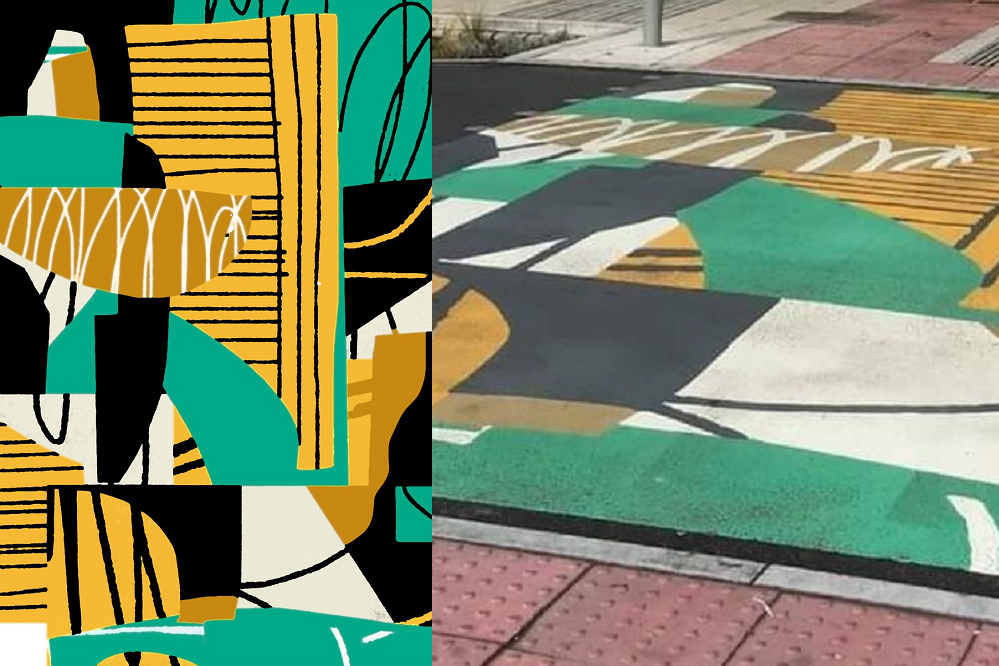Council comes under fire over colourful crossing FOI response

Can you see the difference between these designs? On the left is the plan, on the right the finished result.
Cardiff Council has faced angry criticism over its response to a freedom of information request (FOI) regarding the installation of a colourful crossing on Cowbridge Road East.
In the response, the council confirmed it had received “a number of” objections from disability groups when planning the crossing but said that the “design was amended following additional advice regarding colour and colour tones to minimise negative impacts.”
Critics have hit back at this response, saying there is no visible difference between the original design and the final result, and they accuse the council of not listening to the concerns of people with disabilities.
Sited on Cowbridge Road East in Canton the first of two planned colourful crossings in Cardiff was unveiled last month. The design by artist Steffan Dafydd was selected by public vote, administered by Chapter Arts Centre and Cardiff Council.
In March, Chapter Arts Centre twitter feed displayed all three shortlisted designs, a mock-up of what each would look like in situ, and some artist background
“The abstract shapes in my design are made from taking photos and sketches of the area and cutting parts out to use. After morphing and distorting these different segments and layering them up, it’s impossible to tell what they are”
6/10 pic.twitter.com/qAMdfq3lRF
— Chapter Arts Centre (@chaptertweets) March 18, 2021
After it was installed, some local residents, who had been unaware of the proposal, took to social media expressing concern that the change would prove dangerous and challenging to residents with dementia, sensory or neurological disabilities, children and guide dogs.
On 26 October the freedom of information request was submitted to Cardiff Council asking whether charities that represent vulnerable groups – such as Access Association, Guide Dogs, Transport for All (TfA), RNIB, Scope, Alzheimer’s Society – were invited to respond to the consultation, and if they were, how they responded.
The request also asked the council to outline how it had engaged with local people with disabilities on the matter and how it assessed the equality impact (EqIA) and discharged its Public Sector Equality Duty (PSED) on the decision-making process.
Objections
The council responded to the FOI saying they consulted “Guide Dogs Association, Alzheimer’s Society, RNIB, Diverse Cymru, 50+ Forum, Deaf Hub (Wales), Access Included, Age Connect Cardiff, BDA, Sightlife Wales.
“Objections were received from a number of groups. Concerns were expressed that colourful crossings could be confusing to various groups, including the elderly, those living with dementia and those who are partially sighted,” they said.
“The crossing design was amended following additional advice regarding colour and colour tones to minimise negative impacts.”
When asked what the council had done to ensure that local people with disabilities had been “thoroughly engaged with” the council said: “Over 400 properties in the local vicinity were directly consulted and awareness of the proposal was raised on social media and the Council’s website.”
The council added: “An EqIA has been carried out and the scheme has been discussed in the monthly Access Equality Group meetings. Stage 1 and Stage 2 County Road Safety Audit Reports have also been undertaken. The monthly access group is made up of a number of organisations who were involved in the consultation / engagement process.”
Some residents and disability advocates were however angered by the council’s response and have accused it of lying about making alterations, and simply executing the plans regardless of any concerns.
One person tweeted “Why would you lie about this Cardiff Council? Looking at those two images, it’s clear, no amendments were made to the design. Why did you simply ignore the objections from disability groups and plough ahead with the crossing anyway?”
The council rapidly responded with a tweet stating “Hi, colour tones were amended prior to installation after seeking further input from Alzheimer’s Society. The amended version was viewed by the society before installation. Thanks.”
Voicing concerns over the crossing one person added: “My dad had Parkinson’s and dementia, there is absolutely no way he would have been able to recognise this mess as a crossing (in fact it probably would have scared him to walk over it)”, while another added: “I’ll not be using it as it will cause me visual disturbance & I’ll lose my balance.”
Others point to the fact that projects like this should not be a priority for cash strapped councils who have a continuous battle with potholes, and another said: “There has to be more to this – functionality and safety are being compromised and someone is making money.”
Concerns
The trend for Asphalt Art has grown recently with several cities following the lead set by London’s ambitious ‘city wide’ bid to install public art on roads, which celebrates causes or events.
TfA and a coalition of groups representing people with disabilities sent an open letter to London Mayor Sadiq Khan regarding his initiative, which included 11 crossings on Tottenham Court Road.
As a result of the letter Mr Khan announced that he had put a temporary pause to the plan, saying “I am concerned to read about the issues highlighted in your letter and the negative impact that these types of crossing can have on disabled people.”
RMP, a local authorities and public services risk management company said: “Local Authorities need to consider the legal, financial and reputational implications of installing road crossings which may directly contravene relevant highway regulations, and which may also, in some eyes, be considered to increase the risks to pedestrian and motorist safety which is already significant at these crossings.”
Support our Nation today
For the price of a cup of coffee a month you can help us create an independent, not-for-profit, national news service for the people of Wales, by the people of Wales.





